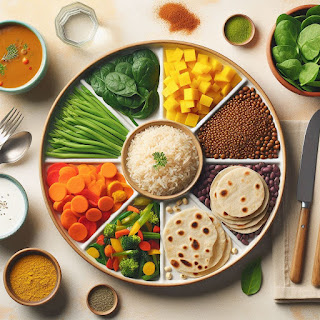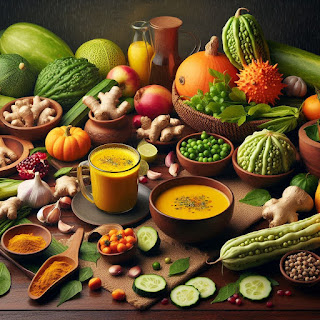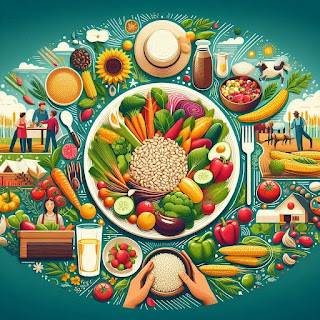நீரிழிவு மேலாண்மைக்கான சிறந்த இந்திய உணவுகள்
நீரிழிவு நோயை நிர்வகிப்பது பெரும்பாலும் அதிக மனஅழுத்தத்தை ஏற்படுத்தலாம். குறிப்பாக முரண்பட்ட உணவு ஆலோசனைகளின் பயனாக உண்டாகலாம். பல நூற்றாண்டுகளாக, இந்திய உணவுகளில் இயற்கையாகவே இரத்த சர்க்கரை கட்டுப்பாட்டை ஆதரிக்கும் சக்திவாய்ந்த பொருட்கள் நிறைந்துள்ளன. இந்த உலக நீரிழிவு தினத்தில், "தடைகளை உடைத்தல், இடைவெளிகளைக் குறைத்தல்" என்ற கருப்பொருளுடன், சில எளிய, பாரம்பரிய இந்திய உணவுகள் எவ்வாறு நீரிழிவு நோயைக் கட்டுப்படுத்தவும் தடுக்கவும் உதவும் என்பதை காண்போம்.
வெந்தயம்
வெந்தய விதைகள் சிறியவை, ஆனால் நீரிழிவு மேலாண்மையில் சிறந்தவை. எளிதில் ஜீரணம் ஆகக்கூடிய நார்ச்சத்து நிறைந்த, வெந்தயம் கார்போஹைட்ரேட் உறிஞ்சுதலை மெதுவாக்குகிறது மற்றும் இன்சுலின் உணர்திறனை மேம்படுத்துகிறது.
வெந்தயத்தை உங்கள் உணவில் சேர்ப்பது எப்படி:
ஊறவைத்த விதைகள்: 1 டேபிள் ஸ்பூன் வெந்தய விதைகளை இரவு முழுவதும் ஊறவைத்து, காலையில் வெறும் வயிற்றில் சாப்பிட்டு வந்தால், இரத்தத்தில் சர்க்கரையின் அளவு சீராக இருக்கும்.
முளை கட்டியது : மொறுமொறுப்பான மற்றும் சத்தான பொருளாக முளைகட்டிய வெந்தயத்தை காய்கறி கலவை, அல்லது உப்புமாவில் சேர்க்கவும்.
மஞ்சள்
இந்தியாவின் தங்க மசாலாவான மஞ்சளில் குர்குமின் என்ற ஆன்டிஆக்ஸிடன்ட் நிரம்பியுள்ளது, இது வீக்கத்தைக் குறைக்கிறது மற்றும் இன்சுலின் உணர்திறனை மேம்படுத்துகிறது. மஞ்சளின் சக்திவாய்ந்த அழற்சி எதிர்ப்பு பண்புகள், நீரிழிவு நோயாளிகளுக்கு ஒரு அத்தியாவசிய உணவாக அமைகிறது.
உங்கள் உணவில் மஞ்சளை எவ்வாறு சேர்ப்பது:
மஞ்சள் பால்: சூடான பால் (அல்லது தாவர அடிப்படையிலான பால்), ஒரு சிட்டிகை கருப்பு மிளகு, மஞ்சள் ஒரு தேக்கரண்டி கலந்து.பருகவும்
மஞ்சள் தேநீர்: ஒரு டீஸ்பூன் மஞ்சளை இஞ்சி மற்றும் இலவங்கப்பட்டையுடன் சேர்த்து கொதிக்கவைத்து அருந்த , இரத்த சர்க்கரையை சீராக்க உதவும்
பாகற்காய்
கசப்பு சுவை காரணமாக பாகற்காய் அனைவருக்கும் பிடித்ததாக இருக்காது, ஆனால் இது நீரிழிவு நோயை நிர்வகிப்பதற்கான சிறந்த உணவாக உள்ளது. பாகற்காயில் பாலிபெப்டைட்-பி (தாவர இன்சுலின்) போன்ற கலவைகள் உள்ளன, அவை இரத்த சர்க்கரை அளவைக் குறைக்க உதவுகின்றன.
உங்கள் உணவில் பாகற்காயை எவ்வாறு சேர்ப்பது:
பாகற்காய் சாறு: பாகர்காயை சிறு துண்டங்களாக வெட்டி தண்ணீர் மற்றும் ஒரு சிட்டிகை உப்பு சேர்த்து கலக்கவும். இந்த சாற்றை வெறும் வயிற்றில் குடிப்பதால் இரத்தத்தில் உள்ள சர்க்கரையின் அளவை குறைக்கலாம்.
பாகற்காய் வறுவல் : மெல்லியதாக நறுக்கி, உப்பு தூவி, வெங்காயம் மற்றும் மசாலாப் பொருட்களுடன் வறுக்கவும், சுவையாக இருக்கும்.
சிறுதானியங்கள்
நார்ச்சத்து, புரதம் மற்றும் அத்தியாவசிய ஊட்டச்சத்துக்கள் நிறைந்த சிறுதானியங்கள் , செரிமான நேரத்தை அதிகரித்து , திடீர் இரத்த சர்க்கரை அளவு உயர்வதை தடுப்பதன் மூலம் இரத்த சர்க்கரையை சீராக்க உதவுகிறது.
உங்கள் உணவில் சிறுதானியங்களை எப்படி சேர்ப்பது:
கஞ்சி: கேழ்வரகு, கம்பு போன்ற சிறுதானியங்களைப் பயன்படுத்தி கொட்டைகள் மற்றும் விதைகளுடன் கூடிய காலை உணவு கஞ்சியை தயாரிக்கவும்.
சப்பாத்தி : சிறந்த இரத்த சர்க்கரை கட்டுப்பாட்டிற்கு வழக்கமான கோதுமை சப்பாத்தியை சோளம் அல்லது கம்பு பயன்படுத்தி தயாரிக்கவும்.
உப்புமா : ஏதேனும் ஒரு சிறுதானிய வகையுடன் காய்கறிகள் சேர்த்து உப்புமாவாக உண்ண இரத்த சர்க்கரை அளவை கட்டுப்படுத்தலாம்
இந்த உணவுப்பொருட்களின் நன்மைகளை அதிகரிக்க:
புரதத்துடன் இணைக்கவும்: பருப்பு, பனீர் அல்லது முட்டை போன்ற புரதம் நிறைந்த மூலங்களுடன் இந்த உணவுகளை இணைப்பது இரத்த சர்க்கரை அளவை உறுதிப்படுத்த உதவுகிறது.
ஆரோக்கியமான கொழுப்புகளைப் பயன்படுத்துங்கள்: உங்கள் உணவில் ஒரு டீஸ்பூன் நெய் அல்லது தேங்காய் எண்ணெயைச் சேர்ப்பது, ஊட்டச்சத்து உறிஞ்சுதலை மேம்படுத்தி, உங்களை நீண்ட நேரம் பசியில்லாமல் வைத்திருக்கும்.
சிறிது சிறிதாக , அடிக்கடி சாப்பிடுங்கள்: ஒரே நேரத்தில் மொத்த உணவாக உண்பதற்கு பதிலாக சிறிய, சமச்சீரான உணவுகளை நாள் முழுவதும் உண்பது அதிக பயனை கொடுக்கும்.
நீரேற்றத்துடன் இருங்கள்: இலவங்கப்பட்டை தேநீர் அல்லது சீரக தண்ணீர் போன்றவற்றை குடிப்பது இன்சுலின் உணர்திறனை மேம்படுத்தி செரிமானத்திற்கு உதவும்.
இடைவெளிகளைக் குறைத்தல்: ஆரோக்கியமான உணவை அணுகும்படி செய்தல்
நீரிழிவு நோயை நிர்வகிப்பது கடினமானதாக உணரலாம், ஆனால் இதற்குப் பதில் பெரும்பாலும் நமது பாரம்பரிய உணவுகளின் நன்மையைத் தழுவுவதில் உள்ளது. இந்த இந்திய உணவுப்பொருட்கள் இரத்த சர்க்கரையை கட்டுப்படுத்த உதவுவது மட்டுமல்லாமல் ஒட்டுமொத்த ஆரோக்கியத்தையும் மேம்படுத்துகிறது, நீரிழிவுக்கு எதிரான போராட்டத்தில் தடைகளை உடைக்கிறது.
இந்த உலக நீரிழிவு தினத்தில், இந்த சிறந்த உணவுகளை நமது அன்றாட நடைமுறைகளில் இணைத்துக்கொண்டு ஆரோக்கியமான உணவுஉண்பதை உறுதிப் படுத்துவோம் . சர்க்கரை நோயைக் கட்டுப்படுத்துவது மட்டுமல்ல; இது நமது மூதாதையரின் ஞானத்திற்கும் நவீனகால ஆரோக்கியத்திற்கும் இடையிலான இடைவெளியைக் குறைப்பது பற்றியது.
நினைவில் கொள்ளுங்கள்: சிறிய உணவு மாற்றங்கள் நீரிழிவு நோயை நிர்வகிப்பதில் பெரிய மாற்றத்தை ஏற்படுத்தும். இந்த இந்திய உணவுகளை உட்கொண்டு , சிறந்த ஆரோக்கியத்திற்கான தடைகளை உடைப்போம்!















































.png)



.jpeg)






